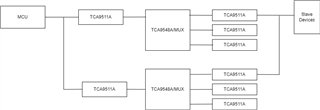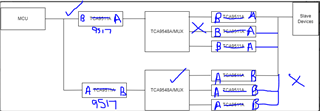Other Parts Discussed in Thread: TCA9548A, TCA9517, , TCA9517A
Hello, I need to create such an architecture. I thought of using TCA9517 to use buffer, but I find it difficult to connect only the A sides together. For example, the input and output of TCA9548A have to be B side. In this case, it is not recommended for TCA9517.
I am thinking of using TCA9511A, but is it healthy to connect its two OUT outputs together? Or I'm open to Buffer architecture suggestions for this architecture. I'm looking for an IC that can be a parallel node on both sides. Can you help me ?




